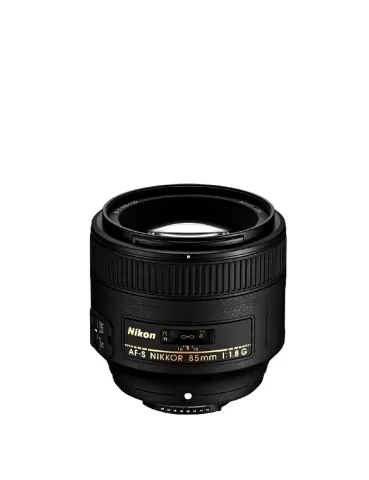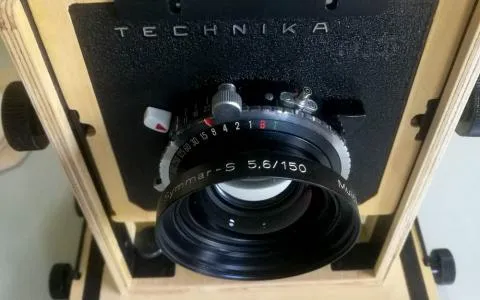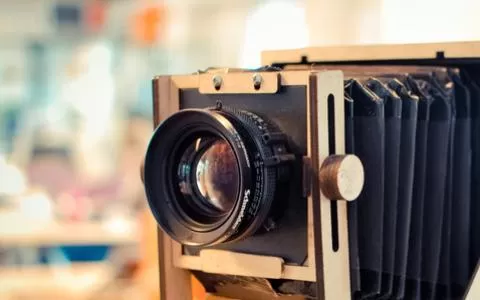You can leave autofocus alone and let the camera decide. Or you can take control, using the AF to your advantage - and probably get better pictures.
Essentially all modern cameras have autofocus (AF). I can't think of a camera without out of the top of my head other than the Leica M range. Of course you can mount a manual lens of an AF body, and you can also disable AF on many cameras, but the far majority of the photos shot in the world are shot with the focusing managed by the camera.
The majority of these auto focused pictures are shot with the standard settings, which will do a nice job most of the time, but sometimes screw up things totally, and also deprive you the control of what's in focus and what isn't.
Everything in focus
Most people don't care much about that, because their camera does a pretty good job. Many cameras take pictures with a very large depth of field, and essentially all important elements in the image are in focus. And people seem to like that. Compact cameras with small sensors, not to mention camera phones will typically have essentially everything in focus.
But if you are using gear that offers a shallow depth of field (DOF) and you utilize it, you need to worry more about focus. Large sensors, bright lenses, long focal lengths will all reduce the apparent depth of field and require you to be more concerned about what's in focus and what's not.
People shooting with a compact camera or a phone will not depend upon that. It focuses and ... click! And most of the image is in sharp.
DOF makes the difference
One thing that sets images taken with pro quality equipment apart from pictures shot with compact cameras and phones is the shallow depth of field – DOF.
Even non-photographers can often spot the professional quality image, but might not be able to say what sets it apart from the average phone or compact camera image. It's often the shallow DOF that's the significant difference.
Just look at many current phone cameras, offering a “portrait” mode that essentially uses software to blur elements in the background to create that alluring bokeh, which is normally a telltale sign of large cameras mounted with expensive lenses.
Let the machine decide
This is the default setting for most cameras:
- The camera focuses when the shutter button is pressed. It locks when the button is half pressed, and typically won't fire until it has found focus.
- The camera selects from a number of AF points and decides which ones to use based on intricate algorithms.
- The camera typically prioritizes the center of the image and the objects nearest to the camera.
- If anything in the image is moving, some cameras can switch to dynamic AF and track whatever seems to be the subject.
This is probably the setting on 80-90% of the world's cameras – heck, some can't do anything else, so there's no choice – and it's about the stupidest setting you can use if you want to control when and where your camera focuses.
I'm not saying that it doesn't work, mind you! It does. And it's very convenient and intuitive. It just assumes things that you might not want it to.
Why and when focus matters
Focus matters when the image isn't fully in focus. That's the case when the depth of field – the area that is in focus – is shallow, and there's a significant difference in sharpness between what's in focus and what's blurred. This difference typically appears when you use larger sensors, brighter lenses and longer focal lengths. So on an SLR with a bright telephoto lens, you can really see what's sharp and what's not, and it really matters where you – or the camera – places focus.
In the above case, the camera decides it all, and in most cases it does fine. But when the subject is just a little out of the ordinary or your aim is to do something a little different, the risk of the camera making a dumb decision is quite big.
Let's look at a couple of examples.
Center is the most interesting
It makes very good sense to use a center weighted priority when finding focus, because people tend to put interesting stuff in the center of the image. But as you know, discerning photographers don't always put things in the center of the frame. Quite the opposite, actually. Rule of thirds, golden ratio and all than jazz. These rules put important stuff off center.
So even though the camera thinks that the center is the most interesting, it might not be, and overruling its decisions is necessary to get the right off-center parts in focus.
Closest is the most interesting
One other thing that most cameras will do it to focus on what's closest. It generally also makes good sense. The chances are that whatever a majority of photographers want to shoot is in an unobstructed line of view from the camera, and probably what's closest to them and the camera.
Line up a person in front of a vista, and it makes sense that it's the person you want sharp and not the view. The far majority of people will prefer a sharp person and a blurred background and not vice versa. But sometimes you do not want the closest in focus.
Faces are the most interesting
Many modern cameras – SLRs as well as lesser capable cameras and phones – can find faces and prioritize them, overruling other priorities like the nearest object.
Faces are important, and oftentimes what you want in focus, but a camera looking for faces will typically consider them as the most important part of the image and prefer focusing on them, which might not be what you want. Consider this scene: a kid holding up a frog, an insect or a piece of toy in front of his or her face. You want the hands and animal in focus. The camera finds the face. Focuses. Locks. Click!
Movement is the most interesting
When the smartest AF systems sense that something is moving, they typically turn from a static autofocus to a dynamic one, meaning that they will start changing focus in order to keep up with the moving object. The smartest of the smart are able to track subjects moving behind other subjects, in other words keep focus on a running person even if one or more other persons move in front of them.
Tracking is pretty neat, and when shooting playing kids, sports or other moving subjects you often benefit from it, but when the camera suddenly decides to focus on a moving object rather than the static one you want to be sharp, it might not be so smart.
It's something you want to turn on when you need it – and off when you don't.
Exaggeration
I think the potential risk of having focus problems is vastly exaggerated and even though the focus problem might be there, most people won't notice.
I shoot most of my bright lens images at low apertures and with shallow DOF and usually have no issues with finding the right place to focus.
Personally I think a lot of focus issues stem from people using multi-point focus and the camera simply deciding to focus somewhere other than what they want. The camera does a perfect job within its scope, but simply decides to focus the wrong place.
Different AF modes
Cameras generally offer two or three focus modes: locking (AKA single), continuous (AKA servo) and hybrid or dynamic. A few cameras offer more modes, mostly for video use.
The three are pretty straightforward.
Locking mode finds focus when you press the button and then locks until you let go and press the button again. Continuous never stops focusing, but constantly tries to find the best focus as long as you press the button. The hybrid or dynamic mode finds focus and locks it, but keeps on looking at the scene, and switches to continuous and refocuses if anything changes.
Which mode you prefer is a question of temper and subjects. The first gives most control, but requires active refocusing when things change.
The second keeps focusing all the time and might miss something because it's constantly adjusting. The last does what it can, but might interpret movement or re-framing wrong and change focus because something irrelevant changes in the frame.
All these modes will do their best to find focus and make the relevant elements in the image sharp, but if you want full control, you need to be the intelligence behind the focusing, and that's possible if you separate focus and exposure.
Separate focus and release
The default is essentially always to engage autofocus when you press the release button. If you half press it, the camera will start focusing, find focus and indicate it in the viewfinder or on the LCD, maybe even with a sound. A full press will then take the picture. As long as you keep the button half pressed the focus is locked if you are in single or locking mode. If you use continuous or servo, the camera will keep on looking for focus until you take the picture. Since cameras focus almost instantly, focus can change very quickly, and you might or might not have the desired object in focus.
Having the focus linked to the exposure might seem like the right way to do this, but it actually isn't!
Having this link means that the camera focuses anew every time you press the release button. While this might appear as a good thing, it's actually way better if you decide when the camera is to focus – independently of the shutter release. This means that the camera stays focused where you want it, no matter how many times you press the shutter release.
Luckily there's a way to do this: back button focus.
Back button focus
A lot of DSLRs have a back button. Many of the higher end cameras have two. You find it, or them, right above your right thumb when you grab the camera with your right hand.
A single one can typically be set to either lock exposure (AE-L), lock autofocus (AF-L) or activate autofocus (AF-On). Mostly the AE-L back button will lock both exposure and focus as long as it's pressed. But through the menu it can be set to do either or to activate AF rather than locking it.
If you have two buttons as it's found on high end bodies, you have a separate AF-On button for activating autofocus. All you need to do to utilize this, is to disengage AF from the shutter release. In Nikon's cameras this is done in the Controls menu.
Now the camera will only focus when you press the back button and not when you press the shutter release.
Continuous vs. single
Once you have disengaged the focus from the release button, you can set the mode to either continuous or single. On some prosumer SLR's this is done in a menu, but on high end cameras there's a button on the camera front to control this.
I personally prefer continuous. As long as I press the button, the camera looks for focus, and when I let go it stops. In locking or single mode, it stops once focus is found, and you have to let go and reengage to refocus.
Focus points
One thing I haven't touched upon is the focus points. Modern SLR's have a large array of focus points, and while 9 or 15 points used to be the standard and still is in many smaller cameras, large, professional SLR's have 40, 50 and even more than 100 focus points arranged in intricate patterns in the viewfinder.
I have to admit than I'm an ungrateful bastard when it comes to focus points. I use one! It's very rare that I switch away from using the center focus point and just that. In a few instances I can choose a center weighted or 3D tracking mode, like when I'm shooting action using a telephoto lens. Apart from that I'm a one focus point man.
Use a single central focus point, and remove the focus function from the shutter release and use the AF-button on the back of the camera. That can be done on all Nikon SLR's including the 5100 - even on the humble D40.
Focus and recompose
When using the single focus point, you will have to use a different way of composing. When you are shooting a scene, the first thing you do is to decide focus. You then point the focus point at that part of the subject, press the rear focus button to get the camera to focus and then let go of the button.
Now your subject will be in focus until you or it moves.
You can compose your image, pan the camera around, find the best way to frame the scene, press and release the exposure button as many times as you want, and the subject you selected will still be in focus.
If it moves or you change position, simply repeat. Focus with the focus point and back button, let go and shoot.
Confusing for some
People have gotten so used to focus and shutter release being coupled, that the rear focus method confuses most. I have had to instruct friends and family many times that if they pick up my camera and take pictures – which I endorse them to do – they need to focus on the rear button. If I don't emphasize this, I get a lot of unsharp images. The single focus point is also an issue. I will work in most cases, but for some situations it will focus totally off the wall... or maybe rather on the wall... like between the heads of a couple being photographed.
In such situations I often turn the camera to what I refer to as a “waiter program”. This is a setting where the camera falls back to the normal standard: multi-point, single, shutter button activated. That will enable most people to use the camera with comfort – including the waiter at the restaurant taking your group picture.
Focus locking
On some longer Nikon lenses you will find buttons on the lens barrel referred to as Focus Buttons. These do the opposite of the AF-On on the camera body, namely turn off the AF and locking it in its current position. These are typically used by action photographers who have the focus coupled to the shutter release.
When they shoot, they can lock focus at a certain point and keep it there even though they press the shutter button several times. The same effect can essentially be obtained with the AF-ON button, but for some it might be more convenient to use the "lens hand" to control focus.





















